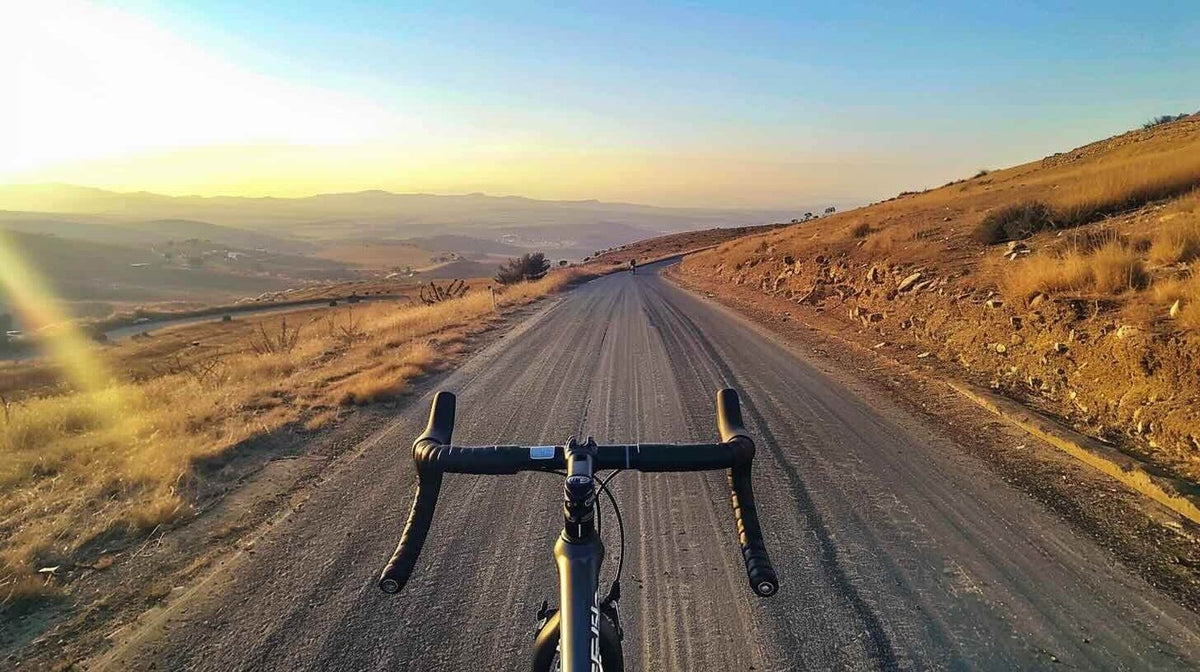
Rennrad-PSI vs. Mountainbike-PSI: Was jeder Fahrer wissen sollte
|
|
Lesezeit 3 min
|
|
Lesezeit 3 min
Egal, ob Sie auf glattem Asphalt fahren oder steinige Trails bewältigen, die Kenntnis des richtigen Reifendrucks für Rennräder und Mountainbikes ist entscheidend für maximale Fahrleistung und Sicherheit. Der richtige Reifendruck steigert die Leistung, erhöht den Komfort und sorgt für Sicherheit bei Rennrad- und Mountainbike-Abenteuern.
Inhaltsverzeichnis
Rennradreifen sind normalerweise schmal und erfordern einen höheren Druck, um den Rollwiderstand zu minimieren und die Geschwindigkeit zu maximieren.
Standardbereich: 80–120 PSI
Schwerere Fahrer: Pumpen Sie näher an 110–120 PSI auf
Leichtere Fahrer: 80–95 PSI für mehr Komfort
Anpassungen:
Reduzieren Sie den Druck bei Nässe um 5–10 PSI, um die Haftung zu verbessern.
Überprüfen Sie dies vor jeder Fahrt, da Straßenreifen mit der Zeit natürlicherweise an Druck verlieren.
Zu starker Druck in Straßenreifen kann zu einer holprigeren Fahrt und einem erhöhten Pannenrisiko führen, während zu geringer Druck zu Durchschlägen führen kann.
Mountainbike-Reifen sind breiter und für einen niedrigeren Druck ausgelegt, um die Traktion auf unterschiedlichem Gelände aufrechtzuerhalten.
Standardbereich: 25–40 PSI für typisches Trailfahren
Technische Trails (Felsen, Schlamm): 22–28 PSI für verbesserten Grip
Hardpack- oder Geschwindigkeitsstrecken: 30–35 PSI, um ein Durchdrehen der Reifen zu vermeiden
Faktoren wie Reifenbreite, Fahrergewicht und Geländebeschaffenheit sollten Ihre PSI-Entscheidung beeinflussen. Überprüfen Sie stets die Reifenseitenwände auf Herstellerempfehlungen. Wenn Sie Hilfe beim Reifenwechsel benötigen, lesen Sie unseren Leitfaden zum Fahrradreifenwechsel .
Überdruck: Reduziert Traktion und Komfort.
Zu geringer Reifendruck: Erhöht den Rollwiderstand und das Risiko eines Durchschlags.
Wetteränderungen ignorieren: Kalte Temperaturen senken den PSI, heißes Wetter kann ihn erhöhen.
Reifentypen mischen: Stellen Sie sicher, dass Felgen- und Reifenbreite kompatibel sind.
Denken Sie daran: Es ist besser, den Reifendruck regelmäßig zu prüfen und anzupassen, als mit falschem Druck zu fahren. Im Falle einer Reifenpanne lesen Sie unsere ausführlichen Tipps zum Flicken eines Fahrradreifens .
Verwenden Sie für genaue Messwerte ein hochwertiges digitales Messgerät.
Überprüfen Sie den PSI, wenn die Reifen kalt sind (vor der Fahrt).
Überprüfen Sie regelmäßig den Reifenverschleiß. Risse oder Beulen sind Anzeichen dafür, dass der Reifen ausgetauscht werden muss.
Passen Sie den PSI saisonal an: In den kalten Monaten etwas höher, um die Haftung aufrechtzuerhalten.
Durch die Aufrechterhaltung eines konstanten, optimalen PSI sind Sie sicherer, effizienter und für jedes Abenteuer bereit. Fortgeschrittene Aufpumplösungen finden Sie in der Woowind-Kollektion mit elektrischen Luftpumpen .
Entdecken Sie die komplette Woowind-Kollektion an Fahrradluftpumpen, um weitere Aufpumpoptionen für jeden Radfahrstil zu finden.
Die tragbare Luftpumpe Woowind BP188 ist ein idealer Begleiter für Rennrad- und Mountainbiker. Kompakt und dennoch leistungsstark bietet sie:
Präzise PSI-Kontrolle zur Vermeidung von Überdruck
Schnelles Aufpumpen für Straßenreifen, MTB und mehr
Leichtes und wiederaufladbares Design für einfachen Transport
Mehrere Düsen im Lieferumfang enthalten für universelle Kompatibilität
Woowind BP188 ist eine zuverlässige, benutzerfreundliche Lösung, die sich an alle Ihre Fahranforderungen anpasst und Ihnen hilft, selbstbewusst auf die Straße oder ins Gelände zu gehen.
Entdecken Sie die komplette Woowind-Kollektion an Fahrradluftpumpen, um weitere Aufpumpoptionen für jeden Radfahrstil zu finden.
Die tragbare Luftpumpe Woowind BP188 ist ein idealer Begleiter für Rennrad- und Mountainbiker. Kompakt und dennoch leistungsstark bietet sie:
Präzise PSI-Kontrolle zur Vermeidung von Überdruck
Schnelles Aufpumpen für Straßenreifen, MTB und mehr
Leichtes und wiederaufladbares Design für einfachen Transport
Mehrere Düsen im Lieferumfang enthalten für universelle Kompatibilität
Woowind BP188 ist eine zuverlässige, benutzerfreundliche Lösung, die sich an alle Ihre Fahranforderungen anpasst und Ihnen hilft, selbstbewusst auf die Straße oder ins Gelände zu gehen.
Normalerweise zwischen 80 und 120 PSI, abhängig vom Gewicht des Fahrers und den Straßenbedingungen.
Im Allgemeinen 25–40 PSI, sollte aber je nach Geländeart und Fahrergewicht angepasst werden.
Idealerweise vor jeder Fahrt, insbesondere bei Rennrädern, bei denen es häufiger zu Druckverlust kommt.
Ja, mit der richtigen Düse. Eine Pumpe wie die Woowind BP188 ist für beide Typen geeignet.
Bei kalten Temperaturen sinkt der PSI, bei Hitze steigt er – passen Sie ihn vor der Fahrt entsprechend an.
Bleiben Sie vorbereitet, fahren Sie klug und sorgen Sie mit regelmäßigen Druckprüfungen und zuverlässiger Ausrüstung wie dem Woowind BP188 für eine reibungslose Fahrt.